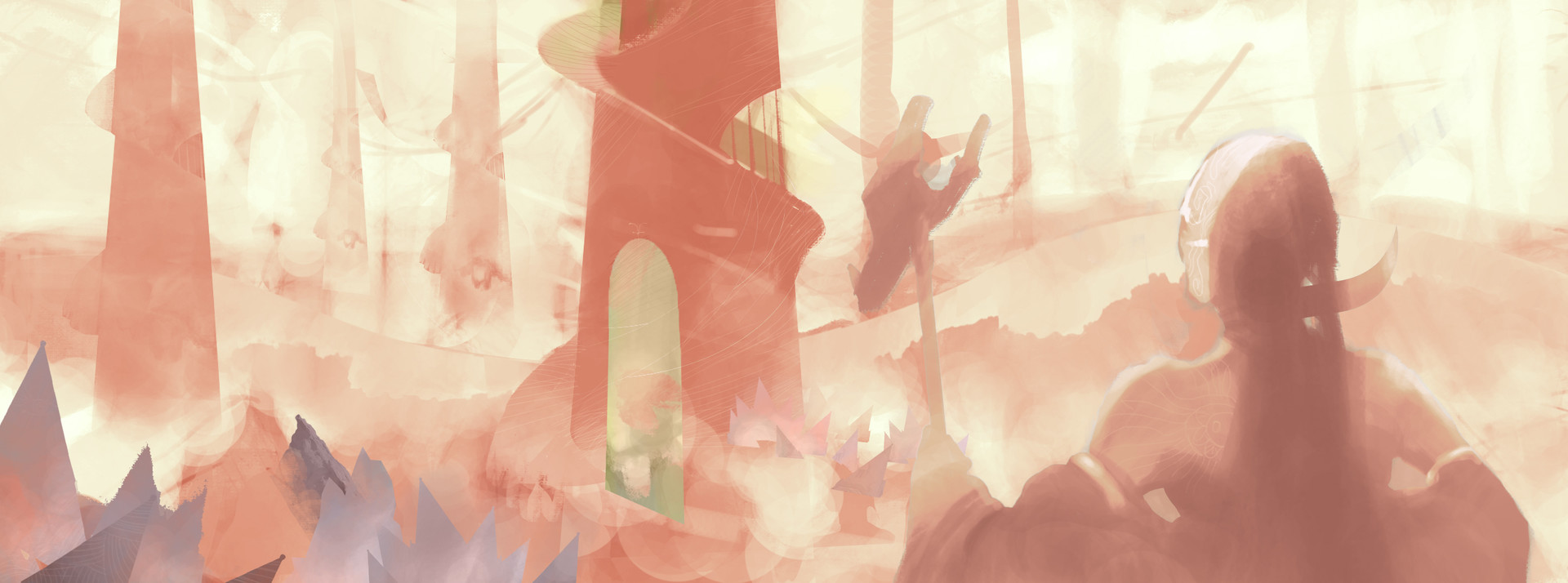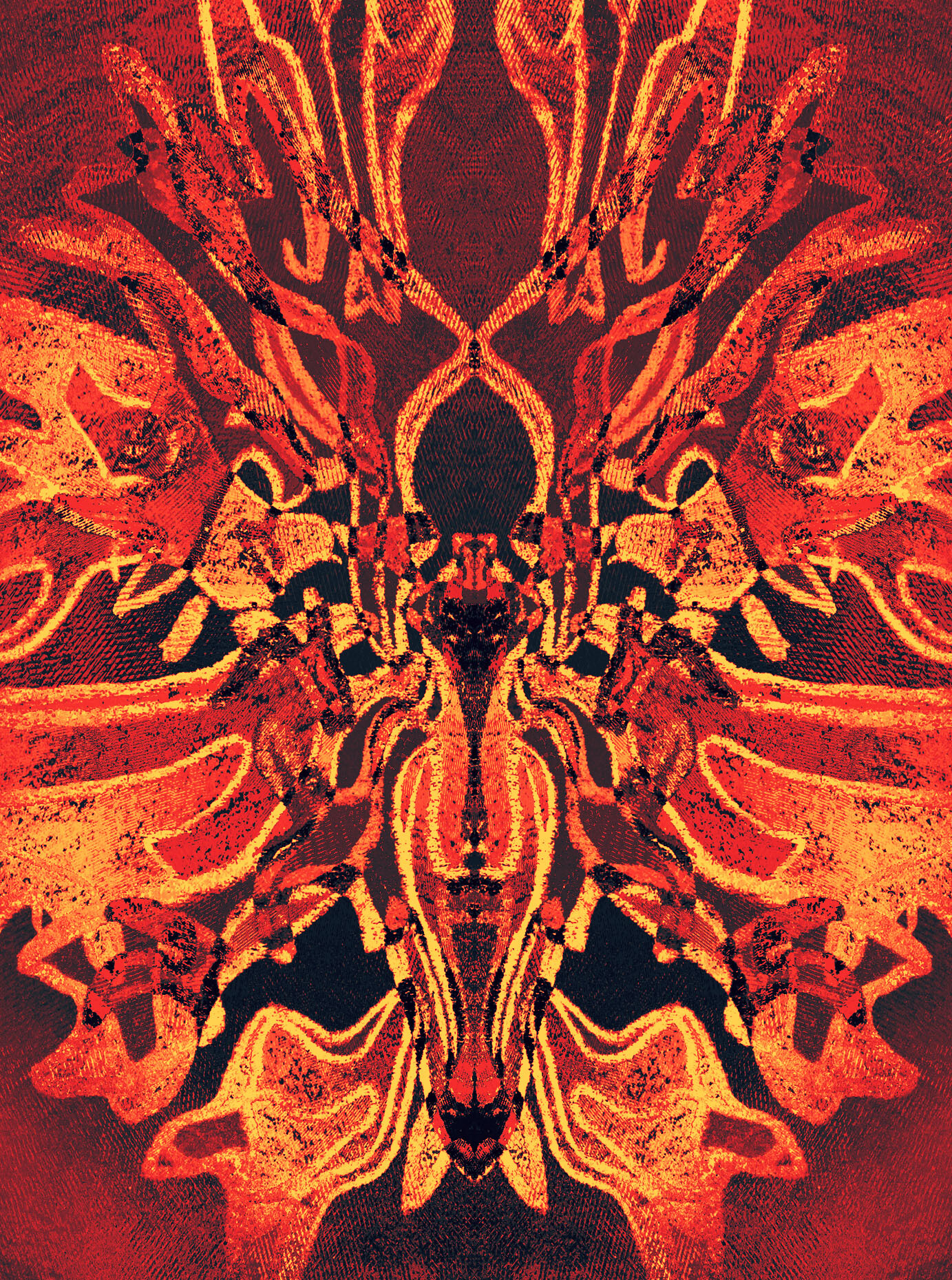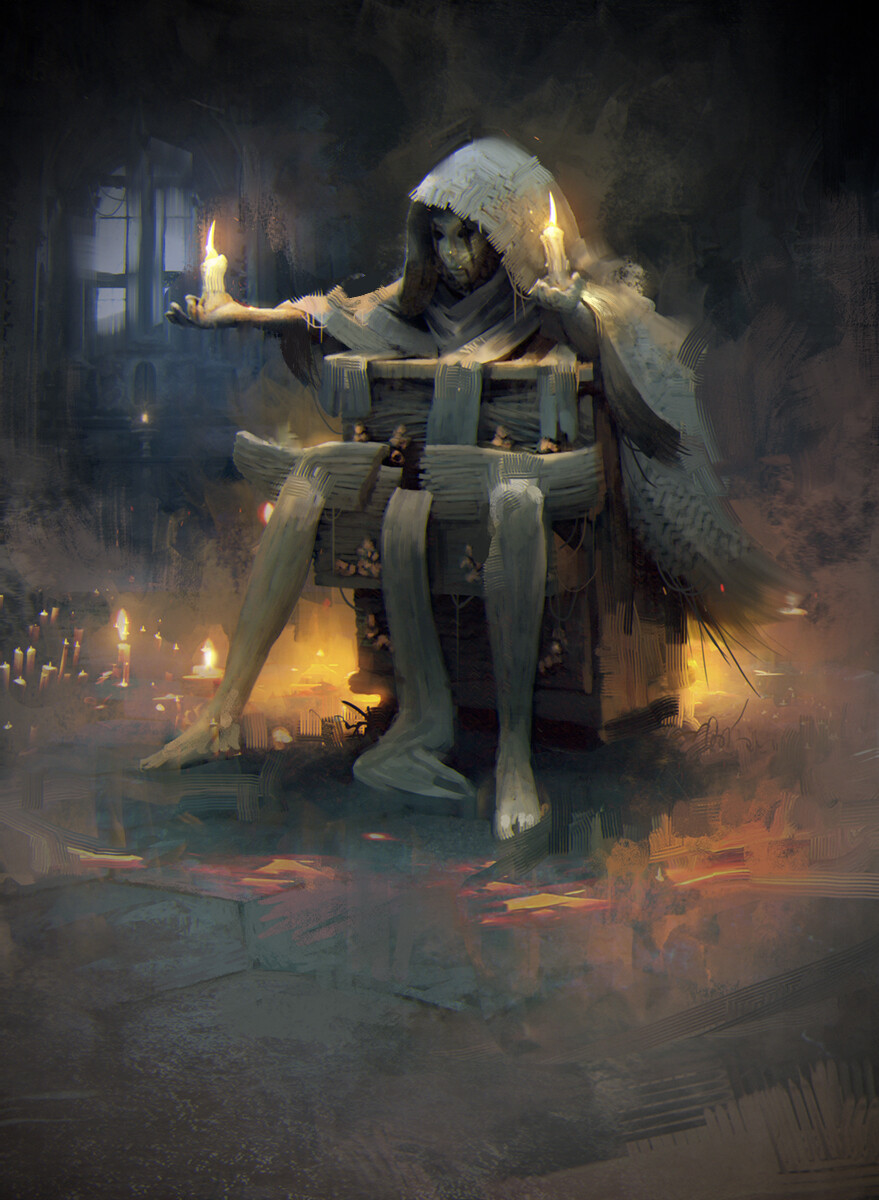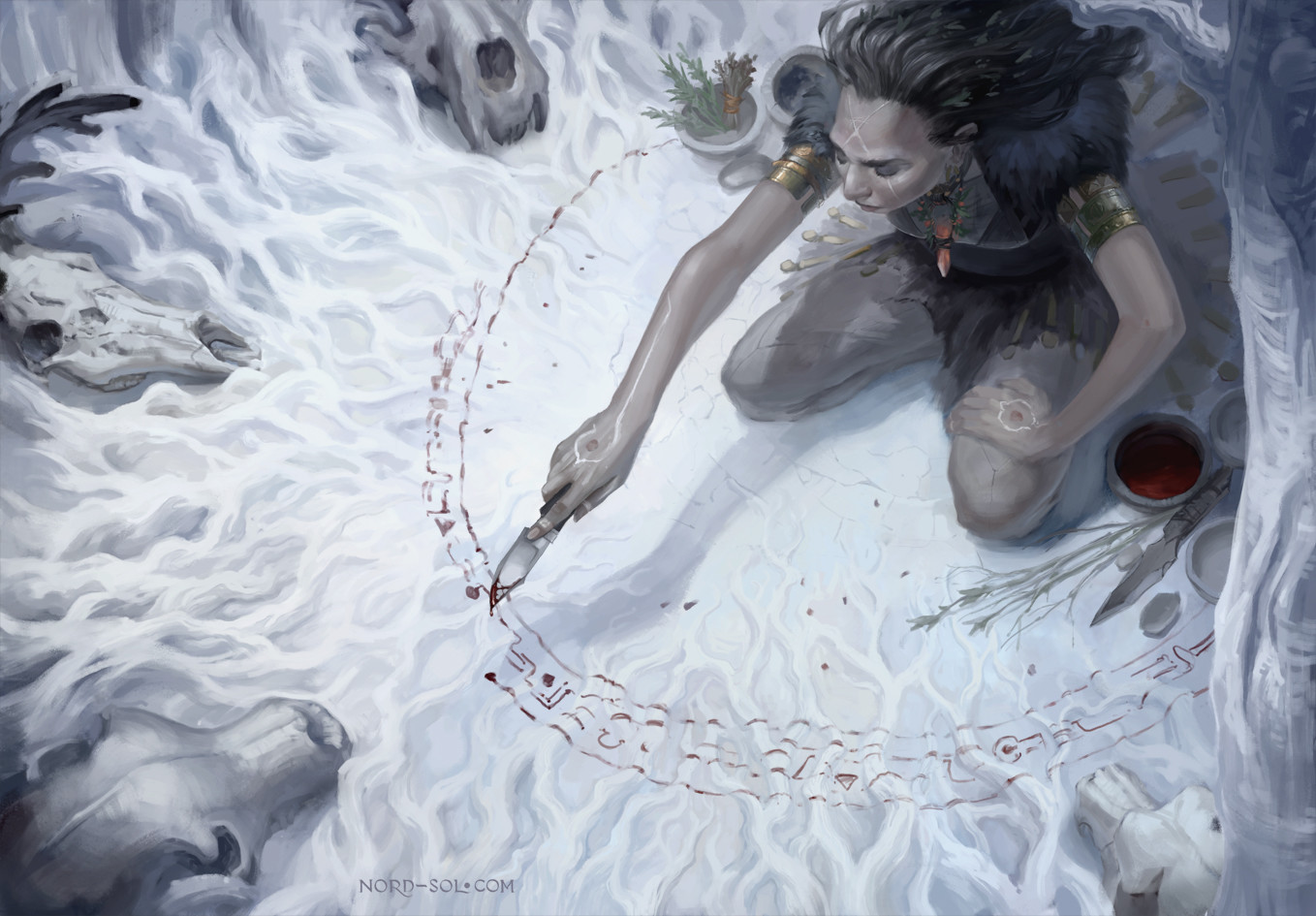The dreampunks have, over the course of the strange, relentlessly passing eons they’ve survived, formed tribes, and from tribes they made juntas, blocs, and sects. Though there are many of these scattered throughout the Eden Under Eventide, those listed below hold the most sway, and each has their seat in Xibalba, where sits the empty Rorschach Throne.
 |
| Alena Kuzminykh |
Monarch’s Mask’d Mercy
Shadows glide gently across the Eden Under Eventide. They wear white masks modeled after their queen, hooded robes too, vantablack, thick enough to keep out the ever-approaching winter and the prying eyes of the ego-blind. They say their hands are the hands of the Monarch. The left is merciful. With it, these masked shadows strip from the dreampunks their ailments and pains. The right is less kind. Still gingerly, filled with love, the Right Hand of the Monarch is a conduit for mortality. Death is imposed upon the still living flesh of the cruel, of nightmare things, reserved for when realities go too far.
To join the Monarch’s Mask’d Mercy is to give up living as you are. Your name is now the number of a verse and the book in which it is found. Your purpose in life is to heal, and, if needed, to harm. From an early age, an acolyte is trained in the Mortal’s Monastery. It is a black, crooked building wherein those secreted within are taught the Enlightenment of Love—a teaching found nowhere else. Dreampunks learn that their lives are born from the Monarch’s kindness, and her stern, death-dyeing touch. They are sent to the far reaches of the Eden Under Eventide on a pilgrimage of suffering where they do what they were taught to do for neither gold nor favor but instead only for a moment of shared prayer.
Leading the Monarch’s Mask’d Mercy is Cessations 3:14. Never do they speak. What goals they have for the Eden Under Eventide are known to none but the shadar-kai, who in turn say nothing and merely watch.
 |
| Igor Kieryluk |
The Dreameating Syndicate
They speak in a code that no others know. They carry with them an amber coin that they flip between their fingers, chew absentmindedly on, spin on a countertop, leave it spinning, stop it with the flat of their hand when murder is due. If dreampunks are alive, than they are life-eaters, just like everything else in the multiverse. That means it is the job of dreampunks who are savvy to this bit of selfish wisdom to steal, take, and control whatever they want. Criminals, the lot of them, spoken of as a neverending threat, or in the way people do terrorists during times of discord. Sometimes this syndicate instead uses its influence to help out its fellow dreampunks. After all, if they were to all die, there would be no more dreams to eat, and thus no life left to live.
Find the Dreameaters throughout the Eden Under Eventide. You won’t know them at first, and they won’t care to tell you what they are. They’re abnormally skilled, more than a little bit clever. Many of them are soulknives who never leave any evidence behind, or Phantoms trained by the shadar-kai for purposes kept secret since the earliest times. Yuan-Ti who become disillusioned with the progress of Xibalba’s civilization fall easily into the syndicate’s plans. Tortles jaded during their long lives, ghostwises separated from their kin—these stories are common for Dreameaters too. Some of them still care for their fellow dreampunks. But because they care, they know they have to do these kinds of things, to protect that which keeps them real, that is, their loved ones, their passions, their own dreams of the future.
All this utilitarianism doesn’t bleach deep enough to remove the Dreameating Syndicate’s sins. They still run rackets, organize crime, or get up to debaucheries and cruel magics and infernal rituals. They’ll trade the souls of the dead for promises and deals and never let regret stop them from doing it again. Beware these, trust them not, lest you know what you offer is more than what your life is worth. Leading the Dreameating Syndicate is the mythical Les Neuf Vies, a rumored dreampunk of no discernable race who has lived and died nine times over.
 |
| Igor Kieryluk |
The Aberrant Bloc
It is no secret that the Eden Under Eventide is haunted still by the echoes of immortal minds long since gifted death. Those echoes call to things from the Far Realm, whom flood alien and warped through the eclipse to terrorize dreampunks. The Aberrant Bloc, born from these events, captures, shatters, and harnesses the minds of the Far Realm aberrations that litter the world. They are hunters, sorcerers, abjurers all, each one constantly training to fully harness their psionics into not just weapons, but roads to enlightenment. These beliefs make the Aberrant Bloc one of the few factions who does not wholly bow to the Raven Queen, nor her Half-Light Diaconate. Instead, they believe that it is them who should rule the Eden Under Eventide, for they are the future of the dreampunks, and they alone offer a path to ascending beyond their half-lives into a greater, more divine thing.
This has led to no civil war, nor will it ever. The Aberrant Bloc and the Half-Light Diaconate are kept in peace by clerics of the latter. Likewise, the Aberrant Bloc is just as focused on political power as they are protecting the Eden Under Eventide from Far Realm incursions. Thus, the Aberrant Bloc has been forced to resort to more indirect methods for their influence wars. They use their protective services to garner influence, convert dreampunks to their beliefs, and therefore increase the power of their bloc. At the same time, they put on demonstrations, parades, and tours throughout the Eden Under Eventide to further preach their superiority. Never does the Half-Light Diaconate respond negatively to these events; the shadar-kai pay relatively little attention to the Aberrant Bloc.
Aberrantcists wear proudly their deformities, attained from their experiments with their captured aberrant prey. Third eyes, slime, cloaks of astral wind—these things mark them wherever they go and they take no effort to hide this. The bloc leaders, called the Mysterions, are said to be so horrifically changed that they no longer appear like their original selves. For this reason, or so the rumor goes, the Aberrant Bloc uses liaisons to communicate the wills of its leaders.
 |
| Lius Lasahido |
Sect of Scriptures
As the shadar-kai teach, dreampunks first learned to write from giants, who used tortle shells for their runestones. With that arcane writing studied and learned, wizardry was born, which in turn led to the dreampunks establishing order throughout the heart of the Eden Under Eventide. Those original scribes game together to make the Sect of Scriptures. With scrolls, grimoires, and holy books in hand, the members of this occult sect explore the Eden Under Eventide, recording, learning, and further establishing order through this chaotic plane. Scribing Wizards are protected by Rune Knights trained either from birth or those who were once criminals and now wish to pay off their sins. Others, such as those who make pacts with Outsiders, or who rely on the clockwork order stolen from Mechanus, find themselves joining the Sect of Scriptures as well, if for nothing else beyond learning the secrets of their magic.
Often told, the story of a sect member stumbling into a fatal yet fated doom. Curiosity is considered both sin and virtue by the dreampunks, and the scribes embody both aspects. Though their developments, always applied to a special branch called the Borromean Rings—small studio-organizations who seek to turn scribed knowledge into artifice—go far in the mission of bringing everlasting peace to the Eden Under Eventide, they also lead to slumbering monstrosities, horrible curses, and the terrifying half-nightmares that hide in those places where twilight cannot reach. Still, the allure of adventure, and to learning deeper truth, sees the Sect of Scriptures replenishing its members every Ecliptic Year.
Eight wizards stand united as the Eight Edenic Roads, whom lead the Sect of Scriptures. They unanimously agree that the Witch Queen planeswalker Iggwilv is their ninth member out of gratitude for the vast majority of knowledge she’s shared with the Sect over the last several centuries. Each of the Roads represents another school of magic, as well as another aspect of the rune writing that was stolen from the now-mad giants. Only through scholarly inheritance can this position be earned. Rare is it that this happens, and rarer is it that the Roads put their collective minds together in the Fifth-Plane Tower to solve any of the Eden Under Eventide’s numerous problems. Their own magical ventures take them far away from where their powers are most needed.
 |
| Bonhotal William |
Knights of Eden
O’ great Knights of Eden, fabled are you, heralded with the dream-joy of those who venture not into the Deep Night or the Haunted Day. Only through valor, glory, skill, or heritage may one be accepted into this most supreme and chivalrous order. Once initiated, a badge, land deed, and stipend are given to the newfound knight by the Xibalban state. The ser or dame is sent off to some remote region of the Eden Under Eventide. Sometimes they are sent alongside different factions. Sometimes they are sent alone. Always are they sent with a mission to protect, slay, and purify, to abjure any wretched reality or cruel aberration, to hunt down the fey courts and free their victims and smash their glass mazes, to expand the Sublime Light that is twilight into those disturbed places where the Weave unravels into threadbare annihilations destitute just as they are absolute.
The Knights of Eden are not always treated like heroes. Many of them cause just as many problems as they solve and for this their reputations are forever besmirched. A knight may have saved some distant outpost, only to sacrifice half the population to do so. Never is this done with malicious intent. The Knights of Eden have no doom-wishes for their fellow dreampunks, nor do they view life as cheap. They simply cannot save every life, and though they try too, their failures become nooses ‘round their necks that keeps their spirits in ache, their resolve ever-sharp.
Shadar-kai from the Half-Light Diaconate appoint a Grand Cross to lead the organization, who inturn appoints ranks as needed to the rest of the knights. Xi Xa Wa is a Yuan-Ti so thoroughly invested in the survival of the Eden Under Eventide that they have sworn a sacred oath to watch over the plane until even their soul turns to dust. So far, they have lived for over five hundred years as a lingering revenant fueled by the Sublime Light.
The Everlasting Troupe
They never sleep and they’ll never die because they’ll never need to stop dreaming nor creating nor living from now until the Eclipse breaks apart and the sun does shine for an eon that stretches from now to the end of time. Every member of the troupe has given themselves wholly to the art of creation. They have realized a deeper truth about the Eden Under Eventide, one that so many others hear but do not believe because they cannot experience it themselves. You see, all things are an illusion, and here, all things are half-dream, and thus, they are the architects of not only their own future but their very world.
Others join the Everlasting Troupe too, addicted either to their performances or their philosophies. Some become monks who change their shape or summon forth the astral self locked within all things. Wildpunks tap into the lingering traces of the immortals whom birthed them, shifting into bestial guises or unleashing souls suffused with enchantment. A ghostwise with a silver tongue will warp the thoughts with every word. A mountain dwarf with a clockwork heart will make impossible odds into absolute destinies. Splintered throughout the Ender Under Eventide this Everlasting Troupe into Everlasting Troupes each with their own ringleaders and their own rules. They tour from outpost to Xibalba and back to outposts, Unearthly Roads rolling lazily before them, trailed by their own strange musics or proceeded by the weird things they’ll let loose in the Weave to announce their arrivals.
All members of the Everlasting Troupe dress like rococopunks. Their make-up is wild. Their outfits are strange. Color splashes them in haphazard patterns that name each performer as something unique. These appearances change with the tour as the performers themselves grow ever closer to revealing their True Self.
 |
| Anato Finnstark |
The Half-Light Diaconate
Mobeds—priests—gloomy, pale and cloaked in feathered black who watch and advise, teach, educate, guidance of a billion year old hand that’s set the stage for tragedy after tragedy after tragedy in the tear-dappled loop that is all time. Every mobed is either a shadar-kai or a dreampunk who has been directly educated by a shadar-kai. Devout and pious to the Half-Light Trinity these clerics, each of whom deeply embodies one gloaming aspect of the Raven Queen. Those inspired by the Monarch are educators and judges both in Xibalba and in the wider Eden Under Eventide. Mobeds forever Soothed embody peace. With a hand enshadowed by twilight they bridge the disparate yet soulbound dreampunk races. And those who radiate the Sublime Light wander far and wide like echoes rebuffed along a canyon’s walls into the outer dark where the most wretched of things are rooted out for the good of all.
Trained by the Diaconate are the bladesingers. It is an art stolen from the Glass Court by dreampunks who use it against their master’s enemies. Each bladesinger is knighted by a mobed or hadur, given two blades of forged silver, taught the secrets of elven wizardry. Set loose they are like secret police, unmarked and unknown save to those with influence or the shadar-kai. Though they are servants of the Raven Queen, they are no more privy to her attentions than any other dreampunk. Thus, only through faith in the Half-Light Trinity can a bladesinger ever hope to one day meet their goddess.
The Half-Light Diaconate is the de facto ruling force of the Eden Under Eventide. They keep the Rorschach Throne empty. They balance the countless factions, listen to the lobbying of all interests, and use strictly democratic vote to determine the directions Xibalba will grow. In this way, they maintain the balance of powers, the supremacy of the Raven Queen, and the Eden Under Eventide’s unique existence as a grand stage for tragedies, revelations, and apotheoses.















